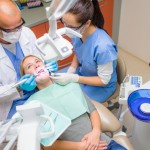
Cusp fractures of restored posterior teeth are a frequent occurrence with the majority being reported as being supra gingival. While crowing the tooth is a conventional treatment approach it does require removal of substantial tooth substance. Adhesive restorations are a potential alternative approach and can be undertaken using direct or indirect approaches. The aim of this study was to compare the five-year clinical performance of direct and indirect resin composite restorations replacing cusps.
Patients requiring the restoration of a fractured buccal or palatal cusp of a vital upper premolar along with a class II cavity or restoration in the same tooth were randomised to direct or indirect restoration of the tooth. Two operators in a university setting carried out all restorations. Patients were reviewed annually with failure being recorded as reparable – (interventions such as polishing after chipping of fragments of resin composite and re-cementation of dislodged indirect restorations); or complete (problems such as caries or tooth fracture and dislodged direct or re-cemented indirect restorations). Levels of failure were categorised at two levels: restoration (dislodgement/cohesive failure) and tooth level (sensitivity, caries, endodontic treatment, tooth fracture, extraction). Time to failure (repairable or complete) was the main outcome of interest with Kaplan-Meier five-year survival probabilities, standard errors, and 95%confidence intervals (CI) being calculated.
- 57 patients (176 premolars) were randomised. 82 patients (92 premolars) to the direct group and 81 patients (84 premolars to the indirect group).
- 17 patients (12 direct and 6 indirect restorations) were lost to follow up (10.2%)
- The mean follow-up period was 5.6yrs for the direct techniques and 6 yrs for the indirect.
- Failures occurred at a mean follow up of 35.4 months (SD, 20.9 months) for the direct technique and 37.4 months (SD, 14.4 months for the indirect technique.
- Twenty-three restorations (8 direct, 15 indirect) failed because of complications at the restoration level, subsequent restorative treatment, or complications at the tooth level.
- Kaplan-Meier five-year survival rates were 86.6% for reparable failure and 87.2% for complete failure
- Differences between survival rates of direct and indirect restorations 89.9% vs. 83.2% for reparable failure and 91.2% vs. 83.2% for complete failure were not statistically significant.
The authors concluded
The results suggest that direct and indirect techniques provide comparable results over the long term.
Comment
While this study does indicate similar survival rate for the direct and indirect approaches as the authors highlight in their discussion all the treatment took place in a university setting so whether these results are generalizable to the general practice environment remains to be answered.
Links
Fennis WM, Kuijs RH, Roeters FJ, Creugers NH, Kreulen CM. Randomized Control Trial of Composite Cuspal Restorations: Five-year Results. J Dent Res. 2013 Oct 23.
